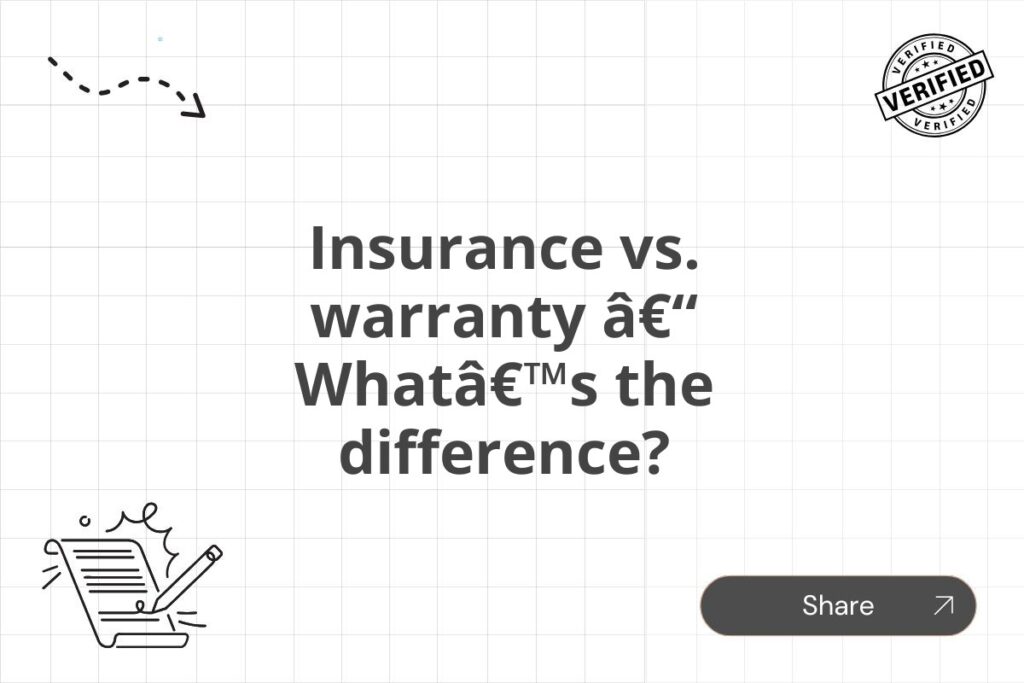Meta Description: Understand the crucial differences between insurance and warranties. Learn which protects against unforeseen events and which covers manufacturer defects. Make informed decisions about your purchases and safeguard your investments. Discover the nuances today!
Insurance and warranties are both designed to protect your investments, but they do so in fundamentally different ways. Understanding the key distinctions between the two is crucial for making informed decisions about your purchases and managing your financial risks effectively. This comprehensive guide will delve into the core differences, helping you navigate the complexities of insurance versus warranties.
What is Insurance?
Insurance is a contract between an individual (the policyholder) and an insurance company (the insurer). In this contract, the insurer agrees to compensate the policyholder for specified losses or damages in exchange for regular payments called premiums. The losses or damages covered are typically unforeseen and unpredictable events. Insurance aims to mitigate financial risk by transferring the burden of potential losses to the insurance company.
Types of Insurance
Insurance covers a vast spectrum of risks, encompassing various types such as:
- Home Insurance: Protects your home and its contents from damage caused by fire, theft, or natural disasters.
- Auto Insurance: Covers damages to your vehicle and liabilities resulting from accidents.
- Health Insurance: Pays for medical expenses, including hospital stays, doctor visits, and prescription drugs.
- Life Insurance: Provides financial security to your beneficiaries upon your death.
- Business Insurance: Protects businesses from various risks such as liability claims, property damage, and business interruption.
Key Features of Insurance
- Protection against unforeseen events: Insurance primarily covers unexpected and unpredictable events that can cause significant financial losses.
- Transfer of risk: It transfers the financial risk of potential losses from the policyholder to the insurance company.
- Premium payments: Policyholders make regular premium payments in exchange for the coverage.
- Claims process: If an insured event occurs, the policyholder files a claim with the insurer, who then assesses the damage and makes a payment based on the policy terms.
- Contractual agreement: Insurance is governed by a legally binding contract outlining the terms and conditions of the coverage.
What is a Warranty?
A warranty is a guarantee provided by the manufacturer or seller of a product or service, assuring the consumer that the product or service will meet specific standards of quality and performance for a certain period. It’s a promise to repair or replace a defective product, essentially offering protection against manufacturing flaws rather than unforeseen events.
Types of Warranties
There are two main types of warranties:
- Express Warranty: This is a written or verbal guarantee explicitly stated by the manufacturer or seller. It clearly outlines the terms and conditions of the warranty, including the duration of coverage and what is covered.
- Implied Warranty: This is an unwritten warranty that exists by law. It guarantees that a product is fit for its intended purpose and is of merchantable quality. This means the product should function as expected and not be defective.
Key Features of a Warranty
- Coverage of manufacturing defects: Warranties primarily protect against defects in materials or workmanship during the manufacturing process. They generally do not cover damage caused by misuse or accidents.
- Limited duration: Warranties typically have a specified duration, after which coverage expires.
- Repair or replacement: If a product is found to be defective within the warranty period, the manufacturer is obligated to repair or replace it, usually free of charge.
- No premium payments: Warranties are usually included in the purchase price of a product or service; no separate premium payments are required.
- Specific conditions: Warranties often come with specific conditions and exclusions. For example, certain types of damage may not be covered, such as damage caused by accidents or improper use.
Insurance vs. Warranty: A Detailed Comparison
The following table summarizes the key differences between insurance and warranties:
| Feature | Insurance | Warranty |
|---|---|---|
| Purpose | Protect against unforeseen events and financial loss | Guarantee product quality and performance against manufacturing defects |
| Coverage | Broad range of risks (e.g., accidents, theft, damage) | Limited to manufacturing defects |
| Cost | Regular premium payments | Included in the purchase price |
| Duration | Can be ongoing or for a specified term | Usually for a specific period |
| Claim Process | Formal claim process with the insurer | Contact the manufacturer or seller for repairs or replacements |
| Risk Transfer | Transfers risk to the insurer | No risk transfer; responsibility lies with the manufacturer/seller |
Extended Warranties: A Special Case
Extended warranties, often sold separately after the purchase of a product, blur the lines between warranties and insurance. While technically a warranty, extended warranties function more like insurance in that they protect against breakdowns and malfunctions beyond the initial manufacturer’s warranty period. However, they are still typically limited to manufacturing defects rather than damage caused by external factors. Carefully read the terms and conditions of an extended warranty before purchasing to understand what is covered.
Conclusion
Understanding the fundamental differences between insurance and warranties is vital for making informed purchasing decisions and managing your financial risks effectively. Insurance provides a safety net against unforeseen events and financial losses, while warranties guarantee the quality and performance of a product against manufacturing defects. By recognizing their distinct roles, you can better protect yourself and your investments.
Remember to always read the fine print of both insurance policies and warranties to fully understand the terms and conditions of coverage before committing. This detailed comparison helps illuminate the distinctions, allowing for a more thorough understanding of your financial safeguards.






















